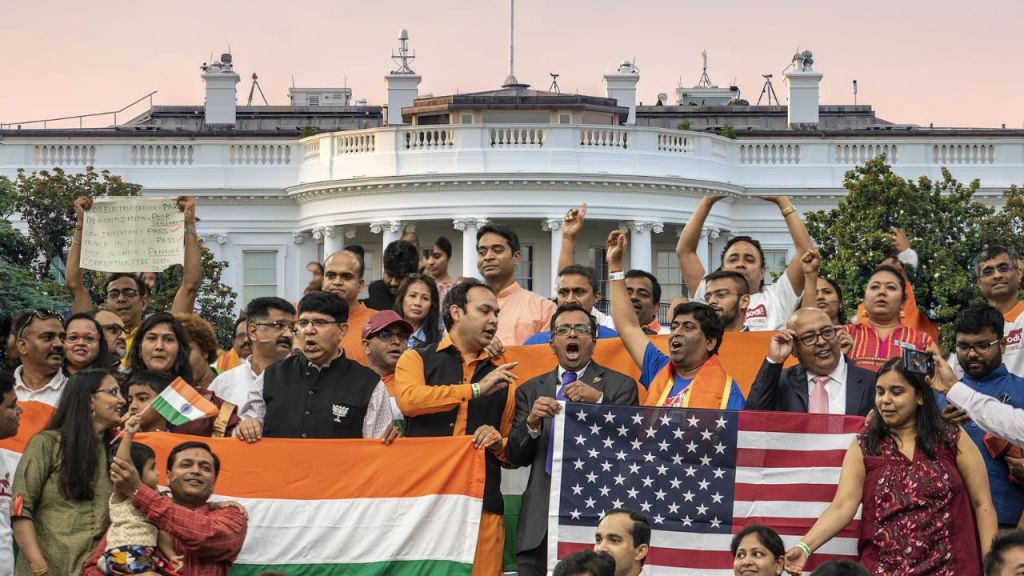The Democratic Primary in Michigan last year was notable, not for who won but for how people chose to be heard. Thousands of Arab-American voters turned silence into protest. To register their disapproval of U.S foreign policy, nearly 13% of the voters, more than 100,000 people cast “uncommitted ballots”, even securing two delegates in the process. It was a powerful example of a community standing together and making its voice heard.
A Tale of Two Protests
Ever since the clip of Shashi Tharoor urging the Indian diaspora in the U.S. to speak up began circulating online, the spotlight has turned to the Indian-American community and its silence over recent changes to the H-1B program, a pathway many of them once used to build their lives here. This silence deserves examination, both from within the community and by those watching it.
Created in 1990 under President George H. W. Bush, the H-1B program was designed to allow U.S. employers to hire foreign professionals to fill critical skill gaps. What is, in reality, a randomized lottery where every applicant has an equal chance of selection, regardless of nationality, is often mischaracterized as a program favouring Indians, simply because they make up the largest share of participants. Counting visa renewals as new approvals, without acknowledging that this cycle exists because of the restrictive country caps and the green card backlog paints a misleading picture of how the H-1B system actually works.
Despite being one of the most visible and affluent immigrant communities in the United States, Indian Americans remain conspicuously quiet about the struggles of newer immigrants. The backlash that followed Sriram Krishnan’s appointment as Senior Policy Advisor on Artificial Intelligence in December 2024, kicked up a hornet’s nest revealing an animosity towards the H-1B holders unlike anything seen before. The fear of reigniting such hostility is one reason many hesitate to speak openly in support of the program.
I don’t expect second or third generation Indian-Americans to shoulder this burden. Nor should they. Their connection to India is a collection of inherited memories and stories and the occasional trip ‘back home’ to India. As Suhag Shukla, Co-Founder and Executive Director of the Hindu American Foundation rightly wrote in her response to Shashi Tharoor- ‘We exist as Americans, citizens endowed with rights, responsibilities and loyalties rooted in this soil’. Assimilation has occurred and rightfully so. It would be unfair to expect them to fight battles they never had to live through, even if they do sympathize with those who still do.
The Disappointment of the First Generation
But it’s the first generation I’m disappointed with. The ones who packed their lives into a suitcase, stood for hours in embassy queues, and left behind the chaos and comfort of home to start afresh in the United States. The ones who have renewed their visas countless times because of the green card backlog, who have missed weddings and funerals of loved ones due to the lack of a visa stamp. The ones who have finally crossed the door and now stand in positions of stability, influence and privilege. Their silence hurts more. Because it comes from those who know. Those who have lived exactly what today’s students and H-1B workers are living. The $100,000 filing fee is the tip of the iceberg. Children aging out, families separated, decades spent in immigration limbo, the list is endless. Yet, instead of advocating for change and amplifying stories, many choose the comfort of indifference. And that, more than any visa backlog or policy failure breaks my heart.
During my conversation on the Area 51 Podcast with Ajay Bhutoria, former member of President Biden’s AANHPI (Asian American, Native Hawaiian, and Pacific Islander) Commission, he pointed out yet another reason. A growing resentment among some first generation families who fear competition for their children. Having struggled to secure stability and success, many view new immigrants more as potential rivals in an already crowded rat race and less as peers on the same journey.
Beneath these layers of fear, comfort, indifference and competition lies something more complicated. Fatigue. Many immigrants spend years proving their worth to the system, to their employers and even to themselves. It’s ironic that the Indian instinct for excellence and constantly demonstrating one’s extraordinary ability follows us even when we are continents and time zones away from India. After finally making it to the other side, many seek peace. Not another set of challenges tied to America’s immigration system. But the reality is that their voices now carry the most weight. And those voices remain silent.
A Moral Obligation: Keeping the Door Open
The Indian-American story has long been celebrated as one of achievement. Of engineers who became CEOs, of students who built successful startups, of a community that left everything behind to chase the American Dream. But stories of success lose their meaning when they forget the struggle that made them possible. If we do not speak for those facing the same challenges we once did, our success becomes incomplete. Silence may once have been a shield, but today it has become a wall. Those who have crossed the door owe it to those still waiting outside not to close it behind them. Crossing the door isn’t success, keeping it open is.
To those outside the community watching this unfold, understand that this silence comes from somewhere real. And to those within it, who have made it through, your younger selves are still waiting.
Disclaimer: Opinions expressed are solely those of the author and not necessarily reflect the views of financialexpress.com.

